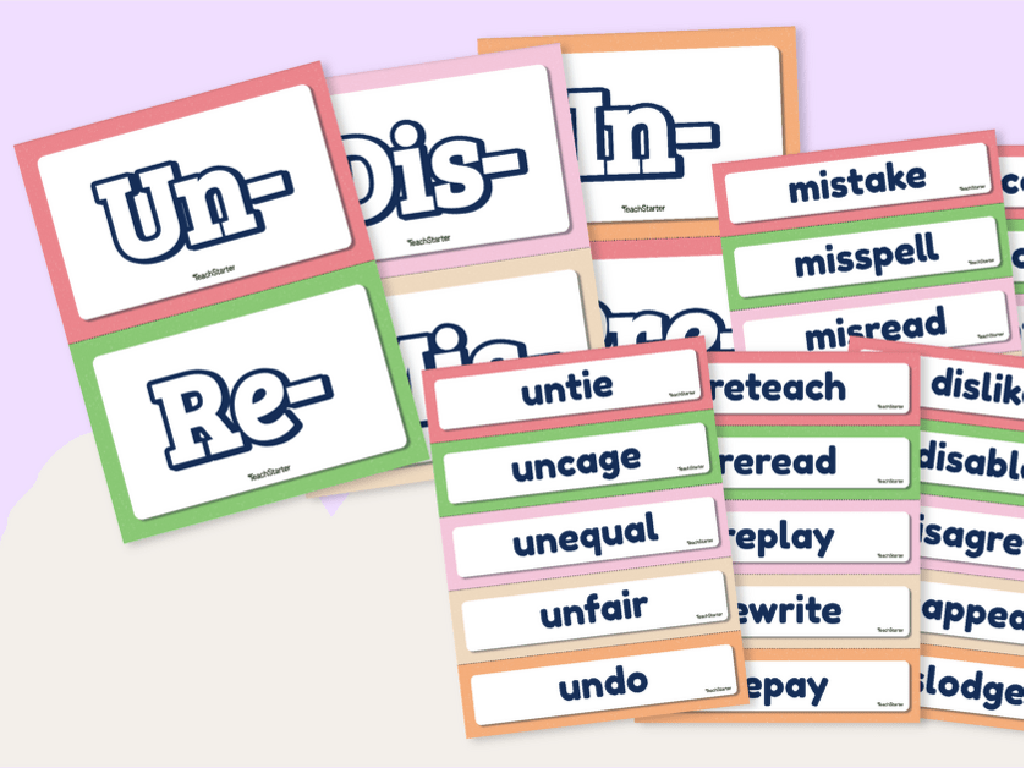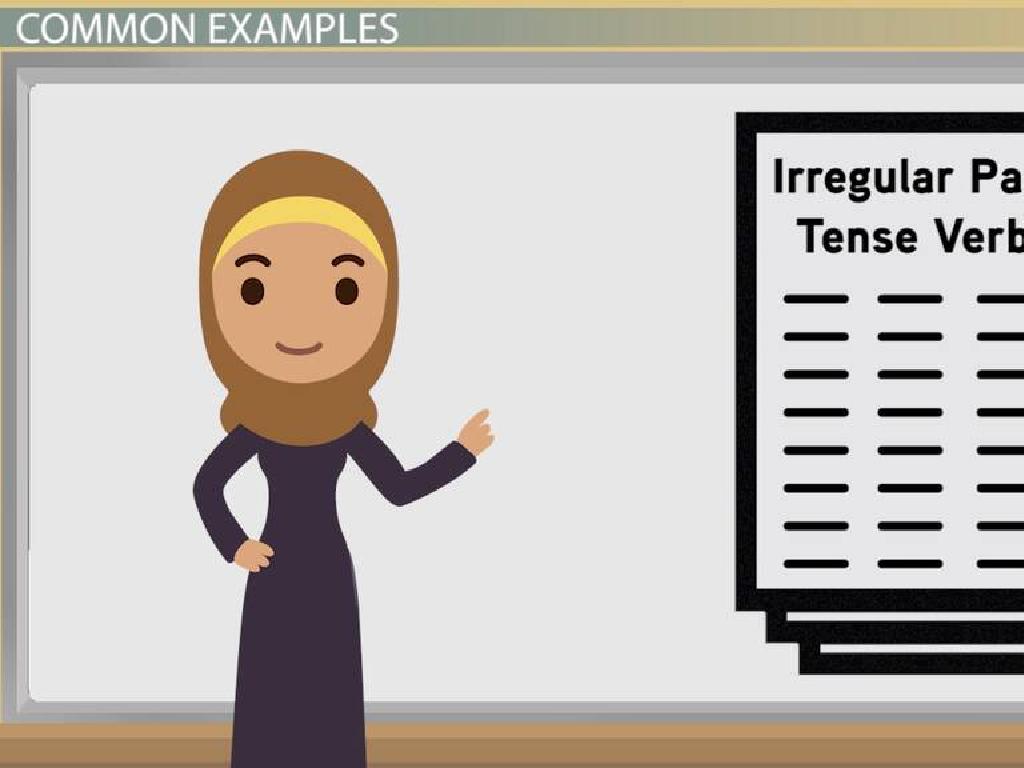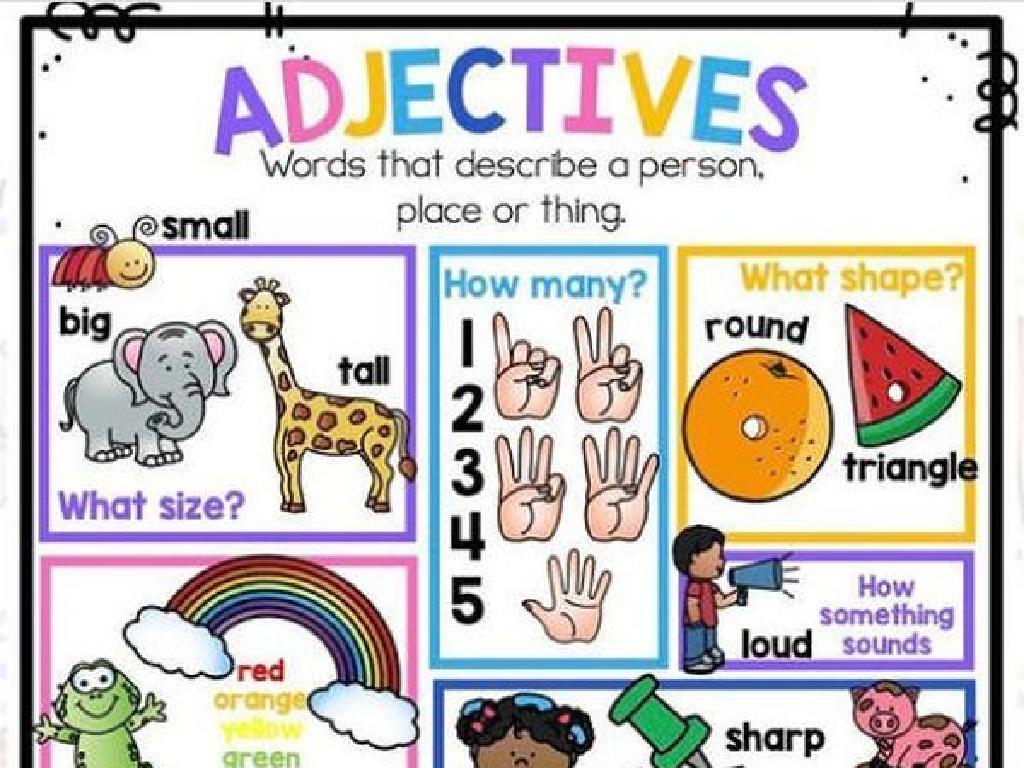Break Apart A One-Digit Number To Add
Subject: Math
Grade: Second grade
Topic: Addition Strategies: Two Digits
Please LOG IN to download the presentation. Access is available to registered users only.
View More Content
Breaking Apart Numbers to Add
– Learn a new addition strategy
– How to break apart numbers
– Split a one-digit number into parts to add
– Why breaking apart helps
– Makes addition simpler and faster
– Practice with examples
– Try adding 6 + 7 by breaking 7 into 5 and 2
|
This slide introduces second-grade students to an addition strategy that involves breaking apart one-digit numbers to simplify the process of adding two-digit numbers. Start by explaining that there are many ways to add numbers, and this strategy can make addition easier and faster. Demonstrate how to break apart a number into two parts that are easier to add. For example, to add 6 + 7, break apart the 7 into 5 and 2, then add 6 + 5 to make 11, and finally add the 2 to get 13. This method helps students to perform addition without having to memorize or guess. Encourage students to practice this strategy with different numbers and provide several examples for them to work through. The goal is to build their confidence in using this strategy independently.
Breaking Apart Numbers to Add
– What does ‘break apart’ mean?
– It means splitting a number into parts
– Example: Break apart the number 8
– 8 can be split into 5 and 3
– Smaller parts help in adding
– Adding 5 + 3 is easier than adding 8 directly
– Practice with different numbers
|
This slide introduces the concept of breaking apart numbers to facilitate easier addition. Explain that breaking apart is like cutting a whole into pieces. Use the example of the number 8, showing it can be split into 5 and 3. Emphasize that adding smaller numbers is simpler and can be done quickly. Encourage students to practice this strategy by breaking apart different one-digit numbers and then adding them together. Provide several examples and use visual aids if possible to help students understand the concept. During the next class, have students share their experiences and discuss any challenges they faced.
Why Break Apart Numbers for Addition?
– Speeds up addition
– Breaking numbers into parts can make adding faster.
– Simplifies mental math
– Smaller numbers are easier to add in our heads than bigger ones.
– Reduces errors with large numbers
– It’s easier to keep track of smaller numbers, which helps prevent mistakes.
|
This slide explains the benefits of breaking apart numbers when adding, especially for second graders who are just beginning to develop their mental math skills. By decomposing numbers into smaller, more manageable parts, students can perform addition more quickly and with greater accuracy. Emphasize that this strategy is a building block for more advanced math concepts and encourage students to practice with examples. For instance, breaking apart the number 8 into 5 and 3 can make it easier to add to another number like 7 (7+5=12, then add 3 to get 15). This method helps students to avoid feeling overwhelmed by larger numbers and to check their work for potential errors.
Let’s Practice Breaking Apart Numbers!
– Break 9 + 5 into 9 + 1 + 4
– It’s like 9 + 1 to get 10, then add 4 more
– First, turn 9 into a full ten
– Adding 1 to 9 gives us 10, a round number
– Then, add the remaining 4
– Now it’s simple: 10 + 4 equals 14
– Makes adding easier!
|
This slide is designed to teach students the strategy of breaking apart numbers to make addition easier. By decomposing a one-digit number, students can round another number to the nearest ten, simplifying the calculation process. For example, with 9 + 5, we add 1 to 9 to get a full ten, then add the remaining 4 to reach the final sum of 14. This method helps students to perform mental calculations more efficiently and builds a foundation for understanding place value and number sense. During the class activity, encourage students to practice this technique with different numbers and share their methods with the class.
Adding with Broken Apart Numbers
– Break apart numbers to add
– Example: 9 + 1 breaks into 10 + 4
– First, break 9 into 9 + 1, then add 4 to make 14
– Adding becomes simpler
– Practice with different numbers
– Try breaking apart other numbers to add
|
This slide introduces the concept of breaking apart numbers to simplify addition. Start by explaining that sometimes adding two-digit numbers can be made easier by breaking one of the numbers into parts that are easier to add. Use the example provided to show how breaking apart 9 into 9 + 1, and then adding the 1 to the other number (4) first, makes the addition easier because it creates a round number (10). Encourage students to practice this strategy with different numbers, both as a class and individually, to reinforce the concept. Provide several examples and possibly use manipulatives or visuals to help students understand the process of breaking numbers apart and recombining them to add.
Your Turn to Try: Breaking Apart Numbers
– Break apart the number 7
– Think of 7 as 5 + 2 and use it to add
– Can we make a ten with 7 + 6?
– Yes, 5 from 7 and 5 from 6 make 10
– Add the remaining part to make ten
– We have 1 left from 6 after making 10
– Combine the ten with the leftover
– Add the 1 left to the 10 we made
|
This slide is an interactive activity for students to practice breaking apart numbers to make addition easier. Start by showing how to decompose the number 7 into 5 and 2. Then, guide students to see that they can combine 5 from the number 7 with 5 from the number 6 to make a ten. Once they have made a ten, they need to add the remaining 1 from the number 6 to the ten. This method simplifies the addition process and helps students understand the concept of making tens. Encourage students to use this strategy with different numbers and provide additional examples if needed. The goal is to make them comfortable with breaking apart numbers to facilitate easier mental addition.
Class Activity: Break Apart to Add
– Pair up and use number cards
– Practice breaking apart numbers
– Break a number into parts to add easier
– Add numbers using this strategy
– Combine the parts to find the total sum
– Share answers with the class
|
This activity is designed to help students understand the concept of breaking apart one-digit numbers to simplify addition. Students will work in pairs to enhance collaborative learning. Provide each pair with number cards. Guide them to break apart numbers into smaller, more manageable parts before adding them together. For example, to add 8 + 5, break apart the 5 into 2 and 3, add 8 + 2 to make 10, then add the 3 for a total of 13. After practicing, each pair will share their method and results with the class, allowing students to learn from each other’s strategies. Possible variations for different pairs could include using different sets of numbers, adding three numbers together, or using visual aids to represent the numbers being broken apart and added.
Conclusion: Breaking Apart Numbers to Add
– Recap: Breaking apart numbers
– Benefits of this addition strategy
– Makes adding easier by simplifying numbers
– Student example demonstration
– Who can show us how they split a number for addition?
– Review and questions
|
As we conclude today’s lesson, we’ll review the concept of breaking apart numbers to add. This strategy involves decomposing a one-digit number into smaller parts to simplify addition, especially when dealing with two-digit numbers. It’s helpful because it allows students to work with smaller, more manageable numbers, reducing the cognitive load and potential for error. We’ll ask for a volunteer to come up and demonstrate how they used this strategy with an example from today’s class activities. This reinforces learning and allows for peer teaching. Finally, we’ll open the floor for any questions to ensure understanding and clarify any confusion before moving on to the next lesson.






